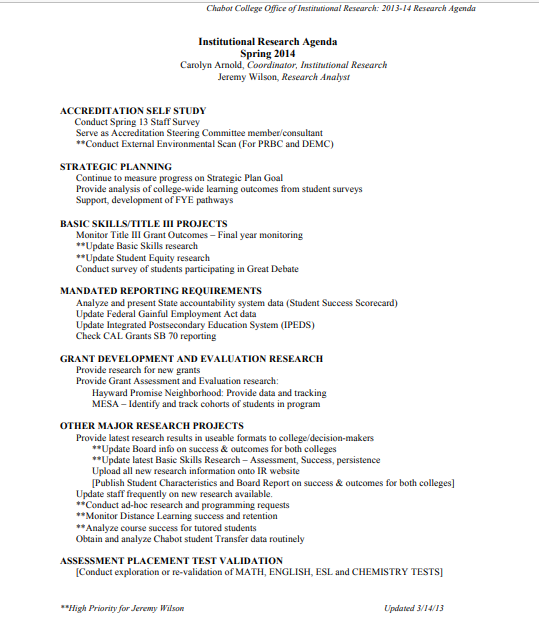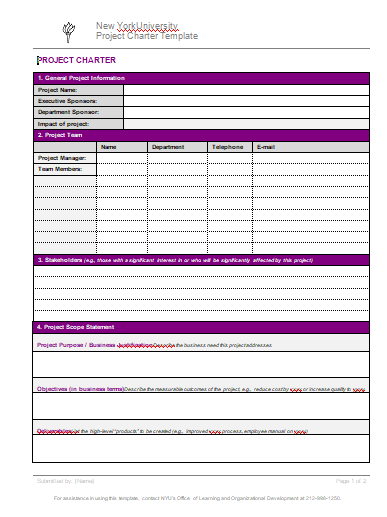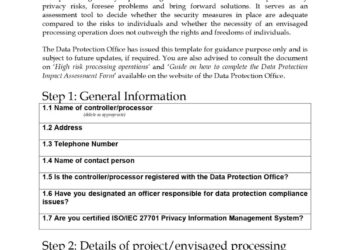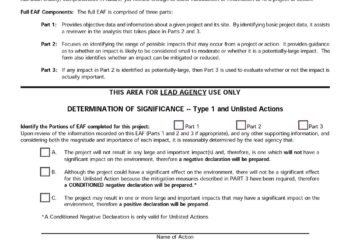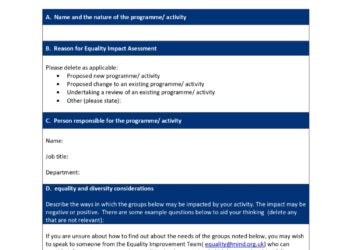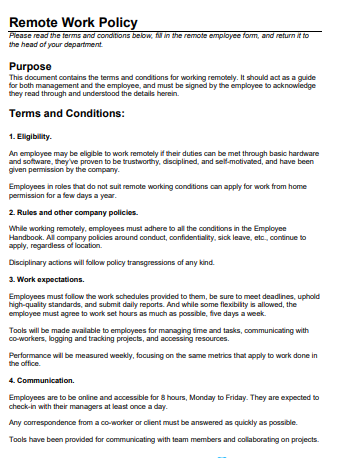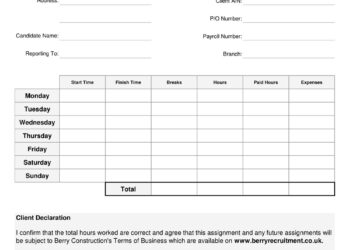Social Impact Assessment Templates are key for any organization conducting research and assessments around the social benefits of their work. The template outlines criteria to assess the real and intangible social benefits of a project or policy, allowing organizations to measure results clearly and consistently.
Social Impact Assessments can provide helpful information that can inform further decision-making around the success or failure of projects or policies, but it is difficult to interpret results without a standard set of criteria established by these templates. Social Impact Assessment Templates should be crafted with careful attention given to account for cultural differences and local context when evaluating outcomes.
Social Impact Assessment Template
Social Impact Assessment 01 |
Social Impact Assessment 02 |
What is a Social Impact Assessment?
A social impact assessment (SIA) is a tool used to evaluate the potential positive and negative effects of an activity or project on people, communities, and the environment. It provides a framework for those involved in the project to identify and address potential concerns before they become serious problems that can cause costly delays or even derailment. SIA helps businesses ensure their projects are not just economically viable but socially responsible as well. Let’s explore how it works.
Purpose of SIA
The primary purpose of SIA is to identify any potential issues that could arise from a proposed activity or project before it begins, thus allowing stakeholders to take steps to mitigate them before they become larger problems down the road. This includes evaluating possible impacts on the environment, local communities, economies, social systems, cultural values, public health and safety, equity considerations such as gender equality, and other related issues that could be affected by the project. It also involves assessing the benefits associated with the activity or project in order to determine whether or not it should be pursued.
Benefits of SIA
There are numerous benefits associated with using a social impact assessment when establishing a new business venture or launching a new initiative. Firstly, it allows companies to stay ahead of any potential issues by identifying them early on and taking steps to address them before they become more serious problems later on.
Secondly, it helps build trust between businesses and their stakeholders by demonstrating their commitment to taking into account all aspects of an activity or project not just economic ones when making decisions about its viability. Finally, SIA can help companies save money in the long run by preventing costly delays due to unforeseen issues arising from their initiatives.
The Benefits for Organizations
SIAs can benefit organizations in a variety of ways. For starters, SIAs help organizations identify potential risks associated with their projects before they begin. This allows them to make proactive decisions about what steps need to be taken in order to minimize negative impacts and maximize positive ones.
Additionally, SIAs can help organizations build relationships with local stakeholders, which can lead to increased trust and support from the community over time. Finally, SIAs also help organizations develop better strategies for responding to any potential issues that may arise during the course of their projects.
The Benefits for Communities
SIAs also offer numerous benefits for communities. First and foremost, they allow local populations to have a say in how projects are developed and implemented in their area. This means that people are more likely to accept proposed changes if they feel like they had some input in the process.
Additionally, SIAs ensure that resources are allocated equitably across different communities so no one group is disproportionately impacted by development projects or policies. Finally, SIAs also ensure that all stakeholders are aware of the potential environmental impacts associated with various projects so everyone can work together towards minimizing them as much as possible.
It Is Also Cost Effective
Social impact assessment can be cost-effective when done correctly because it eliminates costly litigation or delays due to protests from local residents who feel left out of the decision-making process. Additionally, it encourages governments and businesses to think ahead about how they will handle any potential negative impacts on the environment or communities before they begin any development work. This means that they can save time and money by taking measures to minimize such effects before they become a problem.
Federal Laws And Regulations On SIA In The United States
Social impact assessments (SIAs) are an important tool for governments, businesses, and nonprofit organizations to evaluate the potential social, economic, and cultural impacts of their policies or projects. The United States has a number of federal laws and regulations related to SIAs that all stakeholders should be aware of in order to ensure they are taking the necessary steps to protect public health and safety.
National Environmental Policy Act (NEPA)
The National Environmental Policy Act (NEPA) of 1969 is one of the most important pieces of legislation related to SIAs in the US. It requires that any project that may have significant environmental impacts must undergo an environmental review process prior to implementation. This includes determining whether the proposed project would cause any adverse environmental effects or harm any social or cultural values. This may require conducting an SIA as part of the review process.
Clean Air Act (CAA)
The Clean Air Act (CAA) was passed in 1970 and amended several times since then. It sets air quality standards for pollutants such as ozone, sulfur dioxide, particulate matter, carbon monoxide, lead, nitrogen oxides, and other volatile organic compounds. An SIA is often required when considering any changes to existing emissions sources or when developing new sources that could potentially affect air quality standards.
Endangered Species Act
The Endangered Species Act of 1973 requires federal agencies to ensure that their actions do not jeopardize species listed under this act or adversely modify their critical habitat areas. An SIA may be used by agencies before making decisions about activities that could affect endangered species populations or habitats in order to determine if there are any potential adverse effects from those activities.
Conducting an SIA
A Social Impact Assessment (SIA) is a tool for evaluating the potential impacts of a project before it is implemented. It can be used to assess whether the project would cause any adverse social, cultural, or economic effects and foster positive outcomes. In turn, this will help mitigate potential risks and create greater acceptance of the project in the community.
There are many resources available online that provide templates and instructions on how to conduct an SIA, they are useful in helping to organize information systems and identify any negative consequences that the project might have. By taking into consideration all the important aspects of a Social Impact Assessment, one can ensure that their project will not have any potentially harmful outcomes.
Steps Involved In Conducting An SIA
If you are working on a project, chances are you need to conduct a Social Impact Assessment (SIA). An SIA is an analytical process designed to help identify, assess, and predict the social impacts of a project before it begins. This process is critical for ensuring that projects have positive outcomes and do not have unintended consequences. Let’s take a look at what it takes to conduct an effective SIA.
Establish Objectives
The first step in conducting an effective SIA is establishing your objectives. To do this, ask yourself the following questions: What kind of project am I working on? Who will be affected by the project? What are my goals for the project? With these objectives in mind, you can begin to develop your plan.
Research & Analyze Data
Once you know what your objectives are, it’s time to begin researching and analyzing data related to your project. Start by researching current trends and existing studies related to the area in which your project will be conducted. This research can help inform your decisions about how best to proceed with the project. Additionally, consider conducting surveys or interviews with key stakeholders or local residents who may be impacted by the project. This feedback can provide valuable insight into how people feel about the proposed changes and how they might be affected by them.
Monitor & Evaluate Results
Finally, once you’ve begun implementing the project, make sure that you are monitoring its progress and evaluating its results. This includes continually assessing any potential risks associated with the project as well as any potential benefits or opportunities that have emerged as a result of it. Make sure that any adjustments necessary are made quickly so that these results remain positive throughout the duration of the project.
What Are Social Impact Assessment Templates?
SIA templates are a type of development platform that provides users with the tools necessary to quickly design, build, test, and deploy software applications without having to write code from scratch. These systems offer a variety of features, such as drag-and-drop functionality, that make it easier for people to create their apps in an efficient manner. Additionally, these systems come preloaded with templates that can be used to rapidly prototype new applications or modify existing ones.
Benefits Of Using SIA Templates
Social Impact Assessments (SIAs) are an important tool for businesses, governments, and other organizations. The purpose of an SIA is to identify and analyze the effects that a given project or decision might have on the environment, economy, and society. A well-crafted SIA can help ensure that any potential negative impacts are mitigated before they happen. But creating a successful SIA can be difficult and time-consuming. Fortunately, using assessment templates can make the process much easier.
Time Savers
One of the biggest benefits of using assessment templates is that they save you time. When you use an existing template as a starting point for your SIA, you don’t have to start from scratch. You already have questions laid out for you, and all you have to do is fill in the blanks with relevant information about your project or decision. This eliminates much of the guesswork from the process and makes it easier to create accurate assessments in less time.
Improved Accuracy
Another benefit of using assessment templates is improved accuracy. By using pre-designed questions that are tailored specifically to your industry or sector, you can ensure that all relevant topics will be covered during your assessment process without having to worry about missing anything important. This helps ensure that no potential issues are overlooked when making decisions about a project or policy change.
Easier Collaboration
Using assessment templates also makes it easier to collaborate on SIAs with multiple people or departments within an organization. With everyone working off the same template, it becomes much simpler to coordinate tasks between different teams and come up with comprehensive solutions more quickly than if each team had been working on its own individual assessment plans separately from one another.
Types of SIA Templates Available
A Social Impact Assessment (SIA) is a tool used to evaluate the potential impacts of a development project on its social environment. This means looking at how the project will affect the local community, such as changes in employment, housing, health, and education opportunities. It is an important part of any development process and can help ensure that all stakeholders are considered. Here are some of the different types of social impact assessment templates available.
Qualitative SIA Templates
A qualitative SIA template looks at the project from the perspective of qualitative data. It typically focuses on issues related to culture, heritage, lifestyle, and values. The template may include questions about how the project will affect local customs and traditions, religious beliefs, language use, or cultural identities. It may also consider how it could influence people’s sense of well-being or whether there are any potential risks associated with it.
Quantitative SIA Templates
A quantitative SIA template looks at data that can be quantified or measured numerically. This type of template might include questions about how many jobs might be created by the project, what kind of wages they would pay, whether there would be any educational opportunities resulting from it, or what kind of environmental impacts it might have. The answers to these questions can then be used to predict potential outcomes for both people and businesses in terms of economic growth and development opportunities.
Social Return on Investment (SROI) Templates
This type of SIA template focuses on evaluating a project’s financial returns against its social returns that is, its positive impacts on society. Doing this effectively requires gathering information from multiple sources including government agencies, nonprofit organizations, and research institutions in order to accurately assess the impact that a particular project could have on society as a whole. The results can then be used to determine whether or not investing in the project would be worth it for both investors and stakeholders alike.
How to Use SIA Templates Effectively
When using an SIA template, it’s important to make sure that all relevant information is included in each section. Make sure you review all documentation thoroughly including legal documents, environmental assessments, stakeholder surveys, and more, and include any pertinent details in your assessment. This will help ensure that any potential risks are identified quickly and addressed appropriately. It’s also important to take into account both short-term and long-term impacts when completing your assessment so that any future costs or benefits are accounted for as well. Finally, make sure you consult with stakeholders prior to making any final decisions so that everyone has a chance to provide input into the process.
Compliance and Enforcement
Social Impact Assessments (SIAs) are an important tool for assessing the environmental, social, and economic impacts of projects and activities. They provide an analysis of how a given project or activity might affect people, communities, and the environment. SIAs are used to ensure that development projects take into account potential risks and opportunities associated with their activities and meet the applicable regulations.
Ensuring Compliance With Regulatory Requirements
When conducting an SIA, it is important to ensure that all regulatory requirements are met. This can be done by reviewing relevant legislation, case law, standards, guidelines, policies, and other sources of information related to the project or activity under consideration. It is also important to consider how different stakeholders may view the project or activity. Stakeholders can include members of the community affected by a project as well as other parties such as local governments, NGOs, businesses, etc., who may be affected by its implementation.
The assessment should also include an evaluation of any potential risks associated with the implementation of a project or activity. A risk assessment should identify potential hazards associated with a particular project or activity and assess their chance of occurrence as well as their severity if they were to occur. The risk assessment should also consider any mitigation measures that can be taken to reduce these risks in order to protect people, communities, and the environment from harm.
Enforcing Regulations Through Social Impact Assessments
In addition to ensuring compliance with regulatory requirements through social impact assessments (SIAs), they can also be used for enforcement purposes. For example, if a company fails to comply with environmental regulations due to inadequate environmental risk analysis or insufficient public consultation processes during their SIA process then they may face fines or other penalties from regulators for not following proper procedures in conducting their SIA work properly. Additionally, SIAs can help identify actions that need to be taken in order to ensure compliance with applicable laws and regulations in the future.
Conclusion
Social Impact Assessments are an invaluable tool for businesses, governments, and other organizations looking to understand the potential effects of their projects or decisions on society as a whole. However, creating successful SIAs can be difficult and time-consuming which is why many companies choose to use assessment templates to streamline the process and improve accuracy across multiple departments within their organization.
Using these templates saves time while ensuring that all relevant topics are covered during assessments so nothing gets overlooked in decision-making processes for projects or policy changes down the line. All in all, social impact templates offer numerous benefits when used correctly by companies looking to build sustainable policies in their operations moving forward.




